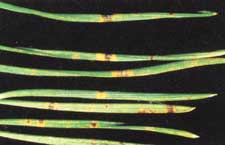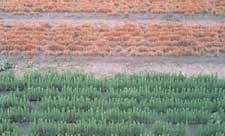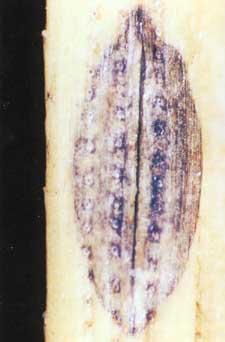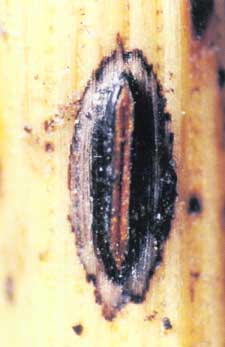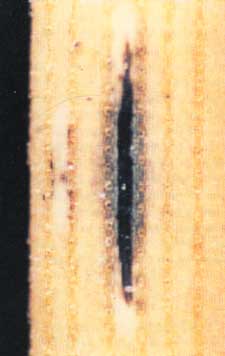Lophodermium Needle CastJohn M. Staley - Plant Pathologist (retired), Rocky Mountain Forest and Range Experiment Station, USDA Forest Service, Fort Collins, CO,and Cordell C.E., Anderson R.L., Hoffard W.H., Landis T.D., Smith R.S. Jr., Toko H.V., 1989. Forest Nursery Pests. USDA Forest Service, Agriculture Handbook No. 680, 184 pp. Hosts Lophodermium needle cast, caused by pathogenic species of Lophodermium, occurs on numerous conifers. Other species of Lophodermium are saprophytes and occur only on dead needles. Some of the more common species of Lophodermium, along with their hosts and pathogenic relationship, are shown in table 11-1. Lophodermium seditiosum is the species most commonly associated with severe damage in nurseries. Nursery damage by other Lophodermium spp. is less well understood. Distribution Lophodermium species are widely distributed; most can be found wherever their hosts are present. Damage Lophodermium needle cast seldom kills seedlings in the nursery but may cause extensive needle loss. If outplanted, however, infected seedlings may perform poorly and could serve as focal points for infection in the plantation. For these reasons, infected seedlings should be culled. Diagnosis In the winter and spring, look for yellow and reddish-brown spots on the needles, some of which may have yellow margins (fig. 11-1). Eventually, the entire needle will turn yellow, then reddish brown. Severely affected seedlings appear scorched (fig. 11-2).
The period in which spores are produced varies with species and climatic conditions but may occur throughout the year. Infection by L. seditiosum usually occurs on current-year needles in summer or fall, but no symptoms are seen until the following winter or spring. Life cycles of other Lophodermium spp. are less well known. Many species of Lophodermium are only weakly pathogenic and produce symptoms only on older, senescent needles. Control Prevention - Do not bring in infected transplants from other nurseries. Do not plant seedlings next to windbreaks of conifers susceptible to Lophodermium needle cast; windbreaks may be reservoirs of inoculum. Clean seedlots thoroughly to minimize the trash sown with the seed. Do not use pine needle mulch. Cultural - Irrigate in the morning so that the seedlings will have time to dry in the afternoon; prolonged moisture is conducive to infection. Chemical - Two fungicides-chlorothalonil and maneb-are registered for control of Lophodermium needle cast. A surfactant is needed for maneb. During rain, do not apply fungicide as it tends to wash off. Spray applications are best during periods of low air movement- during the still, early morning hours, for example-because these periods allow more uniform coverage. Timing of fungicide applications may vary with geographic location and species of Lophodermium. In the Lake States and the Northeast, apply four sprays (August 1, August 15, September 1, and September 15) just before and during the period when spores are released. Where infection is severe and prolonged rainy weather is expected, spraying again on October 1 may be necessary. In the Pacific Northwest, where mild, moist conditions are expected most of the year, experience has shown that from 9 to 12 sprays are most effective. Apply year-round at approximately 1-month intervals except when beds are covered by snow. Table 11-1 - Species of Lophodermium, their conifer hosts, and pathogenic relationship. Selected References Minter, D.W. 1981. Lophodermium on pines. Mycological Papers. 147: 1-54. Minter, D.W.; Millar, CS. 1980. Ecology and biology of three Lophodermium turn species on secondary needles of Pinus sylvestris. European Journal of Forest Pathology. 10: 169-181. Minter, D.W.; Staley, J.M.; Millar, C.S. 1978. Four species of Lophodermium on Pinus sylvestris. Transactions of the British Mycological Society. 71(2): 295-301. Nicholls, Thomas H.; Brown, H. Daniel. 1975. How to identify Lophodermium and brown spot diseases on pine. St. Paul, MN: U.S. Department of Agriculture, Forest Service, North Central Forest Experiment Station. 5 p. Nicholls. Thomas H.: Skilling. Darroll D. 1974. Control of Lophodermium needle-cast in forest nurseries and Christmas tree plantations. Res. Pap. NC-110. St. Paul. MN: U.S. Department of Agriculture, Forest Service, North Central Forest Experiment Station. 11 p. |
Forest Pests: Insects, Diseases & Other Damage Agents |

|
|
